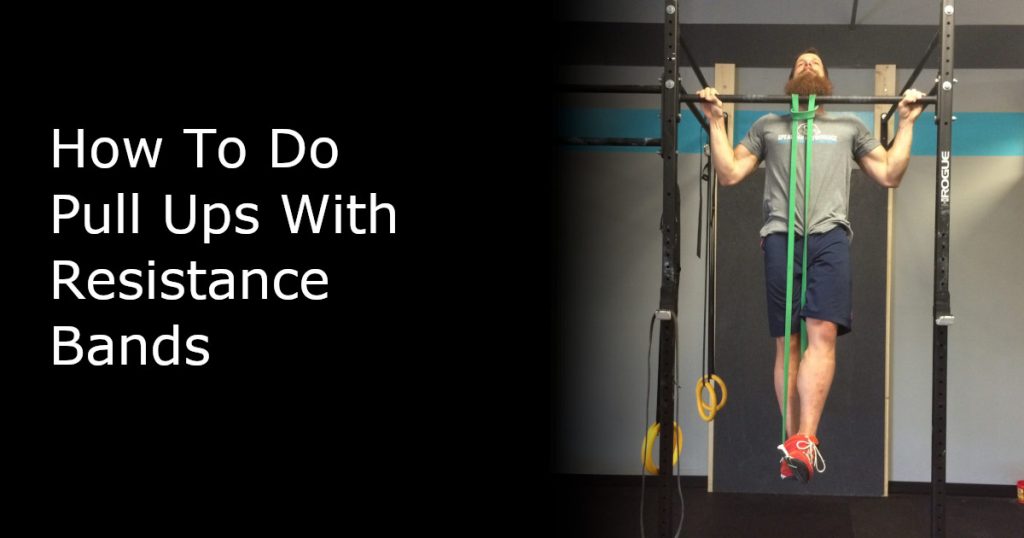Pull-ups are like squats for the upper body.
They work almost every muscle in your upper body, so if you want to look good and get stronger, you need to do pull-ups frequently.
For many strength coaches, the pull-up is the most important upper body exercise. You don’t need a gym membership to do them, and they work your lats, biceps, shoulders, and core, which are important muscles to develop to get a v-taper physique.
However, a problem most people have is doing their first pull-up. Even hardcore gym-goers who bench press and deadlift massive amounts of weight struggle with pull-ups since they are uncomfortable.
In this post, I’ll cover how to do pull-ups with resistance bands and what exercises will help you complete your first pull-up.
Contents
Do Resistance Bands Help With Pull-Ups?
Using resistance bands to complete pull-ups is the most effective way to progress towards bodyweight pull-ups.
Unfortunately, when trying to do their first pull-up, most people bang out a lot of reps on the lat-pulldown and assisted pull-up machine. However, research conducted in 2009 found no correlation between pull-up and pull-down strength.
Meaning, just because you’re stronger on the lat-pulldown doesn’t mean you can do more pull-ups.
When performing a lat-pulldown, you aren’t engaging your core as much as you would when doing a pull-up. Research also shows that your core is the most engaged muscle when performing a pull-up.
But when performing a pull-up with resistance bands, you engage the same muscles you’d use when doing a bodyweight pull-up. This strengthens your core, thus improving your pull-up strength.
How Do You Workout With A Pull-Up Band?

If you’re starting out, I suggest using the thick, green resistance band since it provides 50-125 lbs of support. The thicker the band, the more assistance you receive.
Once pull-ups with this green band become too easy, you can go for thinner bands like the purple and red ones.
Step 1: Attach The Band To The Bar
Regardless of whether you’re working out at the gym or at home, you can attach your resistance band to the pull-up bar. Feed the band through by pulling one side through the other. This secures the band to the pull-up bar, and you can move on to step 2.
Step 2: Place Your Knee Inside
Once the resistance band is attached to the bar, move it slightly off-center so that it’s close to your right hand. This ensures that it’s aligned with your right knee. If it feels more comfortable to place your left knee inside, then position the band close to your left hand.
If you’re struggling to perform banded pull-ups, then feel free to hook your foot inside the band because it increases the support, making the movement easier. However, this can be unsafe. If the band slips off your foot, it’ll hit your head. To ensure this doesn’t happen, put your other foot over the band.
Step 3: Pull Up
Now that the band is secured and you’ve gripped the bar, pull up until your chin is over the bar. Many beginners can’t feel their back being worked when pulling. This is because you haven’t built a mind-muscle connection yet.
To build a mind-muscle connection, don’t grip the bar with your thumb. Think of your hands and forearms as hooks that pull your body up. With this mindset, you’re pulling with your back, not your arms.
Now that you understand how to perform a banded pull-up with proper form, let’s look at the benefits of banded pull-ups.
Are Banded Pull-Ups Good?
Banded pull-ups are the simplest way of progressing to your first pull up, but, it presents other unique benefits:
- It strengthens your upper body and pulling strength
- Banded pull-ups improve your grip strength
- It builds a strong core
Banded Pull-Ups Strengthens Your Upper Body
Banded pull-ups are one of the best ways to build upper back strength as a beginner. Pull-ups are compound movements, so they work several muscles at once, making them easy to overload.
Some of the muscles that pull-ups work include:
- Lats
- Shoulders
- Biceps
- Forearms
- Core
You’ll also notice that these are all the muscles that give you an aesthetic physique. When training for a show, bodybuilders put emphasis on these muscles because it gives them that famous v-taper.
By working up to your first bodyweight pull-up and implementing weighted pull-ups, your upper body will grow quickly.
Banded Pull-Ups Improve Your Grip Strength
You’re only as strong as your grip strength.
Unfortunately, most exercises don’t put much emphasis on grip strength.
Many people focus on deadlifts and although deadlifts are a crucial exercise to build muscle and grip strength, it takes a lot out of your central nervous system. This means you can’t do a lot of volume.
But with pull-ups, you can train them 4 to 5 days a week to failure, and you won’t feel burnt out. This increased volume improves grip strength.
After doing a few sets of pull-ups to failure, you’ll notice that your forearms, hands, and fingers start to ache. Depending on how strong your upper body is, your grip strength might be the first to give out.
For me, after I focused on pull-ups, I noticed that other exercises like bent-over rows, deadlifts, and farmers’ walks became easier.
Banded Pull-Ups Engages Your Core
Like we discussed earlier, a stronger lat-pulldown doesn’t mean a stronger pull-up.
This is because lat-pulldowns don’t engage your core as much as a banded pull-up. Also, if you’re strengthening all your other muscles but neglecting your core, then you’ll experience dangerous muscle imbalances.
With a strong core, you can:
- Reduce back pain
- Improve your posture
- Increase your everyday strength
Four out of five Americans suffer from back pain which makes the simplest tasks like walking and sitting extremely difficult. However, most people don’t know that a common reason for back pain is a weak core.
A weak core promotes forward-leaning posture with less spinal stability. You’ll notice that a list of core exercises is often prescribed when dealing with back pain. Luckily, if you focus on getting better at pull-ups, your core will become rock solid.
When Do I Switch To Bodyweight Pull-Ups?

If you started out with the green band, try to complete 10 pull-ups before using the purple band with less resistance. After you can bang out 10 pull-ups with the purple band, start using the thin red band. This offers almost no assistance.
If you can do 5 to 10 pull-ups with the thin red band, you’ll be able to complete your first rep. You might also do 3 or 4 reps depending on how well you’re rested.
After a few months of pull-ups, you’ll notice it’s not that challenging anymore. You can easily bang out 15 to 20 pull-ups. This is when it’s time to add weight. You can get a weight belt and some weights off Amazon for a few dollars, and you’re good to go.
What Exercises Help With Pull-Ups
Although banded pull-ups are necessary to progress to your first bodyweight pull up, here are a few other options to spice up your workout routine:
- Scapula pull-ups
- Negative pull-ups
- Inverted rows
Scapula Pull-Ups
To perform scapula pull-ups, get into a pull-up position and without bending your arms, try to bring your chest towards the bar. You’ll notice that it requires you to move your scapula up and down, which can be exhausting yet effective.
Scapula pull-ups work your lower traps which are underdeveloped in most people. Your lower traps are responsible for bringing your shoulders back and improving posture. It’s also a prime mover when doing pull-ups.
Negative Pull-Ups
Negative pull-ups will always have a special place in my heart since I did it every day for weeks before doing my first pull-up.
The concept is simple. Place a chair under a pull-up bar, grip the bar, and jump into the top of a pull-up position. Lower yourself as slowly as possible. First, aim for 10 seconds, and as it gets easier, increase it to 20 or 30 seconds.
Inverted Rows
Lastly, the inverted row is a beneficial exercise when trying to do your first pull-up since it engages your traps more than barbell movements like bent-over rows.
Strong traps ensure that you have the support needed to perform your pull-up.
Final Word On Pull-Ups With Resistance Bands

Doing pull-ups with resistance bands is one of the best ways of building the upper body strength needed to pull yourself over the bar. The best part is, resistance bands are available for people of all strength levels. Whether you can’t perform a single pull-up or you’re trying to increase your pull-up volume, resistance bands are the answer.


